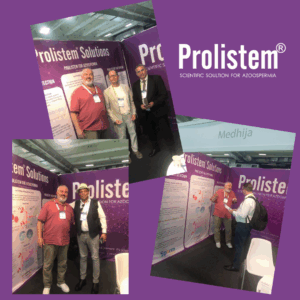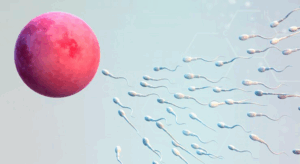
Prolistem® at the ESHRE 41th – Paris
We are proud to have participated in the 41st Annual ESHRE Conference in Paris, a premier international event where the global reproductive medicine community gathers

Is Prolistem effective for azoospermia? This question is vital for many men struggling with infertility due to azoospermia — a condition characterized by the absence of sperm in the ejaculate. Azoospermia affects nearly 1% of the male population and accounts for 10-15% of infertility cases worldwide. Among treatment options, Prolistem, a natural supplement aimed at stimulating sperm production, has gained attention. This article explores Prolistem’s effectiveness, its ingredients, clinical evidence, user reviews, and considerations for men with azoospermia, especially non-obstructive azoospermia (NOA).
Azoospermia can be broadly classified into two types: obstructive and non-obstructive. Obstructive azoospermia occurs due to a blockage in the reproductive tract, preventing sperm from mixing with semen. In contrast, non-obstructive azoospermia involves impaired or absent sperm production in the testes, often linked to hormonal imbalances or testicular failure.
For men with obstructive azoospermia, surgical correction or sperm retrieval techniques are often effective. However, non-obstructive azoospermia presents a greater challenge as the problem lies in sperm production itself. This is where supplements like Prolistem may offer hope by promoting spermatogenesis naturally.
Prolistem is a dietary supplement formulated to support male fertility by enhancing sperm production, particularly in men diagnosed with non-obstructive azoospermia. Unlike general fertility supplements, Prolistem focuses on improving the hormonal environment and testicular function essential for sperm development.
The supplement contains a blend of antioxidants, amino acids, and essential micronutrients that target the root causes of impaired sperm production.
Prolistem’s formula combines several clinically studied ingredients known to benefit male reproductive health:
L-Carnitine: Supports energy metabolism in sperm cells and improves motility.
L-Arginine: Enhances blood flow to reproductive organs, aiding nutrient delivery.
Coenzyme Q10: Acts as a potent antioxidant, protecting sperm from oxidative damage.
Zinc: Vital for testosterone synthesis and sperm formation.
Selenium: Supports sperm quality and motility.
Folic Acid: Assists DNA synthesis crucial for healthy sperm.
Myo-Inositol: Regulates hormonal balance and promotes sperm maturation.
Together, these ingredients aim to reduce oxidative stress, improve hormonal balance, and stimulate sperm production.
The core question remains: is Prolistem effective for azoospermia? Evidence suggests that Prolistem may provide benefits primarily for men with non-obstructive azoospermia who retain some capacity for sperm production.
Many users report hormonal improvements, particularly in testosterone and follicle-stimulating hormone (FSH) levels, within the first 6 to 8 weeks of treatment. These hormonal shifts can lead to the appearance of sperm in the ejaculate in some cases after consistent use for 3 to 6 months.
However, the effectiveness depends on the underlying cause of azoospermia and individual patient factors. Men with complete testicular failure or genetic causes may see limited benefits.
Although comprehensive large-scale clinical trials on Prolistem are still emerging, smaller studies and physician reports have documented positive outcomes:
A study monitoring men with NOA revealed improved hormone profiles and the detection of sperm in semen samples after 90 days of Prolistem supplementation.
Fertility specialists often recommend Prolistem as part of pre-surgical protocols before sperm retrieval methods like testicular sperm extraction (TESE) or micro-TESE, aiming to improve success rates.
These findings suggest that Prolistem can play a supportive role in enhancing fertility treatment outcomes.
Many men suffering from azoospermia have shared encouraging testimonials after using Prolistem:
“After three months on Prolistem, my semen analysis showed the presence of sperm for the first time in years. We then successfully conceived through assisted reproduction.” — Michael, USA
“My hormone levels improved significantly, and I was able to retrieve viable sperm during micro-TESE surgery after taking Prolistem.” — Arjun, India
Individual results vary, but such stories provide hope to many facing infertility.
For optimal effectiveness, it is generally recommended to take two capsules daily after meals. Because the full sperm production cycle takes approximately 74 days, a treatment period of at least 3 to 6 months is advisable before assessing results through semen analysis.
Regular medical supervision during treatment is important to monitor hormonal levels and track progress.
Prolistem is widely regarded as safe when taken as directed. Some users may experience mild side effects such as nausea, headaches, or digestive discomfort. These symptoms are usually temporary.
If side effects persist, it is recommended to discontinue use and consult a healthcare provider.
Unlike many over-the-counter fertility supplements, Prolistem is specifically formulated to address azoospermia by targeting spermatogenesis. While other supplements like FertilAid or Conception XR focus on general fertility improvement, Prolistem’s composition is tailored toward men with NOA.
Combining Prolistem with healthy lifestyle habits can maximize fertility benefits:
Maintain a balanced diet rich in antioxidants and essential nutrients.
Avoid smoking, excessive alcohol consumption, and recreational drugs.
Reduce stress through mindfulness, yoga, or counseling.
Exercise regularly, but avoid overheating the testicles (avoid hot baths and saunas).
Ensure adequate sleep and hydration.
Is Prolistem effective for azoospermia? For many men with non-obstructive azoospermia, Prolistem offers a promising, non-invasive option to stimulate sperm production and improve fertility potential. While not a guaranteed cure, its scientifically backed ingredients and positive clinical reports make it a valuable addition to fertility treatment plans.
Men considering Prolistem should consult with a fertility specialist to ensure it aligns with their specific diagnosis and treatment goals.
Q: Can Prolistem cure azoospermia?
A: Prolistem may help restore sperm production in cases of non-obstructive azoospermia, but it is not effective for all men.
Q: How long before seeing results?
A: Hormonal improvements typically appear within 6 to 8 weeks, with sperm possibly appearing after 3 to 6 months.
Q: Is Prolistem safe?
A: Generally, yes, with few reported mild side effects.
Q: Can it be combined with other treatments?
A: Yes, but consult your doctor before combining supplements or medications.

We are proud to have participated in the 41st Annual ESHRE Conference in Paris, a premier international event where the global reproductive medicine community gathers

Introduction: A New Era of Hope for Male Infertility The promising cure for azoospermia 2025 is redefining the future of male fertility. As medical science
Prolistem, a patented formula, has not been evaluated by the Food and Drug Administration. This product is not intended to diagnose, treat, cure, or prevent any disease.
PROLISTEM® is a Patented Formula
Copyright © 2025 Prolistem®